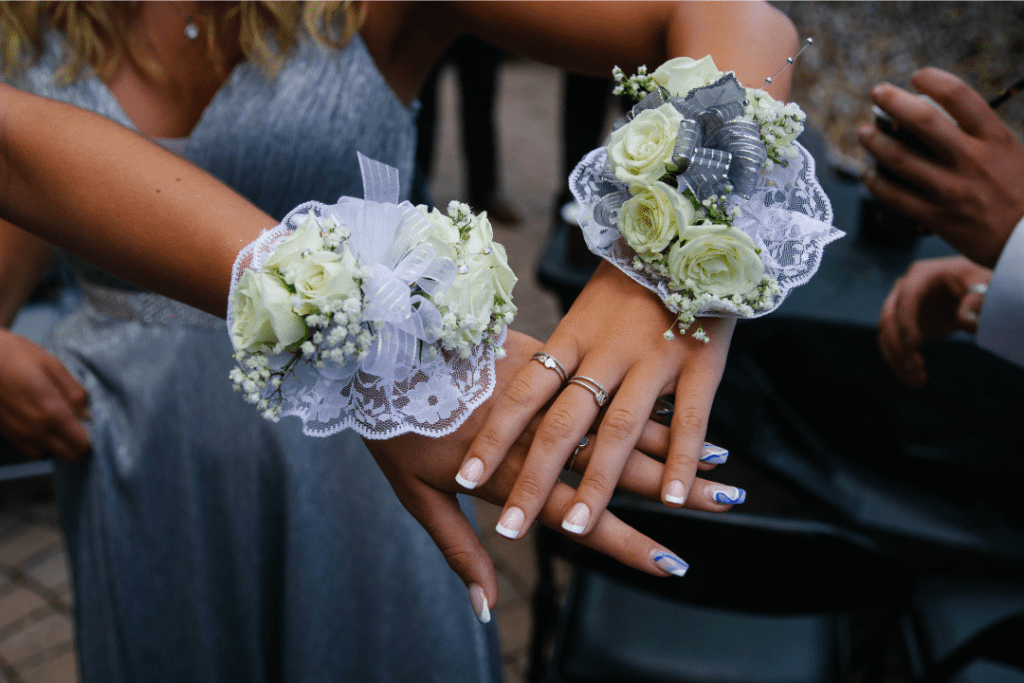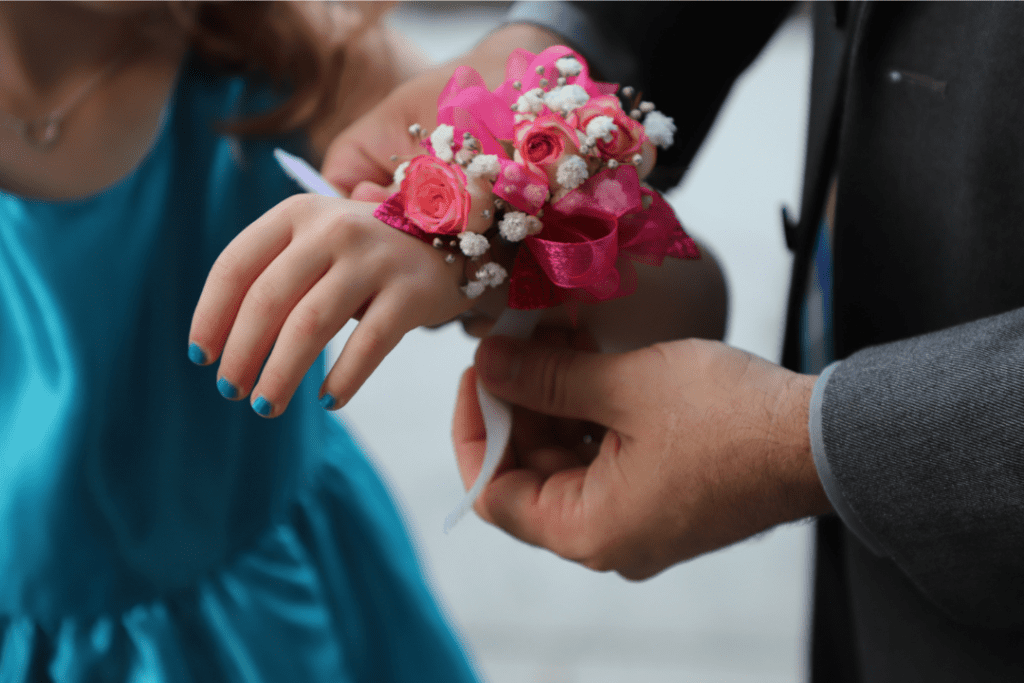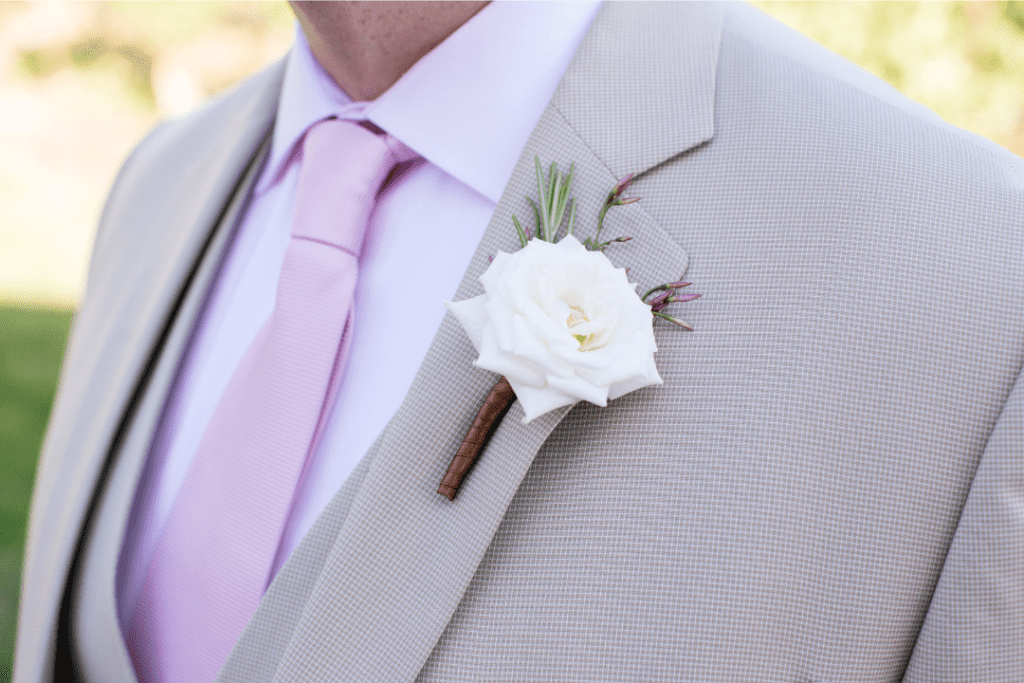Flowers have been an innate part of wedding ceremonies since the dawn of time; aside from the traditional bouquets and centerpieces they have also been incorporated in corsages and boutonnieres! So what exactly is a corsage and who should have them.
A corsage signifies and identifies all the female members of the wedding party. They are usually worn by the Mothers of both the bride and groom along with the Maid of Honor and Bridesmaids. It’s important to note that traditionally, bridesmaids carry bouquets, but times are changing and some couples lean towards corsages these days – especially the sleek, bracelet-type ones that are worn on the wrist.
It is good to know that the Mother’s corsages tend to be slightly different from the rest of the wedding party. They tend to have different flowers. Magnolias, lilies, and roses are all viable options, but the main thing is to ensure that they match their dress while still standing out.

Other than that, the grandmothers on both sides also wear corsages. Other close members of the family or VIP guests may also be given one. However, it totally depends on how small or large your affair is.,
Corsages usually consist of a single or multiple-flower bouquet (granted that it’s a tiny one) that is worn around a woman’s wrist. It’s usually attached to a clasp or a ribbon, which is then tied to secure the arrangement where needed. Corsages must complement the dress color/theme, so the flowers should be selected accordingly. That’s because sometimes, they are directly pinned to the dress instead of being tied to the wrist.
Whoever chooses the corsage must have a keen eye for color combination and contrast. You don’t want to pick out flowers that would end up clashing with the dress and end up ruining the overall aesthetic of your attire.
Corsages symbolize more than just a wedding. They can be used for graduations, proms, baby showers, and other formal occasions. Your flower choice depends on which occasion you’re arranging it for and the type of flower that you’re opting for.
Want to know more about corsages? Here’s everything you need to understand about wearing corsages at a wedding:

Just like everything at a formal event, there’s an etiquette for wearing corsages as well. But first, here’s a bit of history.
You see, corsages used to be pinned exclusively on the bodice of a woman’s dress. In fact, it was the bodice that was referred to as a “corsage” and the French used to call the flowers “bouquet de corsage.” Over the centuries, trends changed and corsages evolved as well. While it used to be worn in the center of bodice it now is now worn to the side of the chest (nearer to the heart). It moved to the wrist when spaghetti strap dresses became all the rage.
As for which wrist the corsage should be worn on, it’s the left one. The main reason for that is it’s mostly the non-dominant side and thus the flowers have lesser chances of getting caught up or destroyed during the event.
Here are all the things that you need to look for when coming up with your wedding corsage ideas:
Like all other decor and accessory items at a wedding, a corsage should work in tune with your wedding theme. You don’t want to select flowers that would ultimately clash with the overall color scheme and dress theme. For weddings, come up with a dress code for the wedding party and select your corsage accordingly.
The size of the corsage totally depends on your preference. However, as a rule of thumb, anywhere between 1 to 5 flowers are used to make an ideal one. Usually, a single flower corsage is paired with frou-frou accouterments like ribbons, beads, and other volumizing additions like baby’s breath stems, etc. On the other hand, a 4 or 5 flower corsage is already large enough and can be accompanied by simple leaves or beads to make it look wholesome.
It’s important to know that there are always things you can add to your corsage in order to make it personalized and unique. For example, laces and ribbons are used to add volume to the design, whereas sometimes, the fabric is also used to add contrast.
As for what types of flowers to choose, roses, gardenias, orchids, and even carnations are pretty good options. That’s because they’re quite sturdy and don’t wilt or fade as quickly.
There’s just something really special about making your own corsage. It is an excellent way to personalize something for your wedding/special occasion and it’s a great craft activity you can take on with a loved one.
Moreover, DIY corsages can also save you a bunch of money by purchasing you flowers in bulk from a company that caters to the consumer, such as Flowers for Le$$. You can either pick fresh or fake flowers, though most people prefer to go for fresh ones because of their freshness and authenticity.
Once you have all your materials together it’s time to create your corsage. Start with floral wire and create a tiny bouquet that would either go on a wrist-length ribbon, elastic or a pin, depending on where you want to wear it.
Pro tip: Give your florist enough time to source flowers for you, so that you can get the best deal and get your order with enough lag time that it won’t hamper the making process.

In contrast to corsages, boutonnieres are reserved to identify the male members of the wedding party. The boutonniere itself consists of either a single flower, but sometimes, it may also comprise a bigger cluster. It depends on the theme of the wedding and what flowers are being used.
The flowers of the boutonnieres are arranged so that their stems are a part of the design. While wearing, the stems are inserted into the buttonhole or the lapel of the coat. However, clothing trends have changed and coats sometimes no longer come with button holes. This is why boutonnieres have also evolved and the flowers are now arranged on a pin or magnet that can be directly attached to the vest or dress shirt.
Boutonnieres are what the guys of the wedding party wear on the lapels or breast pockets of their tux coats. The other men who wear boutonnieres are the fathers, grandfathers, and VIP guests. But most important of all – boutonnieres are worn by the groom. Note that the groom’s boutonniere should be different from the rest of the wedding party, just like the bride’s bouquet is bigger and more distinguished than that of the bridesmaids.
Other men who can wear a boutonniere is the ring bearer, officiant, and ushers to set them apart from your wedding guest.
Fun Fact: Boutonnieres are usually attached to the left side of the lapel – close to where the heart beats. It’s a fun parallel to the pin-up location of the corsage.
So, we hope you now understand the difference between a corsage and a boutonniere, along with how both of them should be worn on your Big Day.


Make your tables look like a showpiece using our floor-length tablecloths. We offer a variety of colors and sizes, prints, and textures from our in-house design collection, and don’t forget about your cocktail tables, cake table, and welcome table when choosing the suitable linen for your tables.